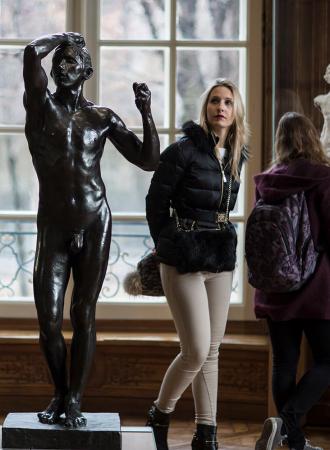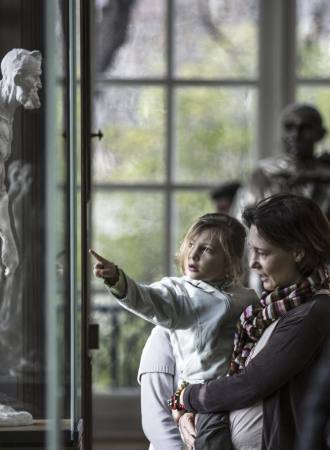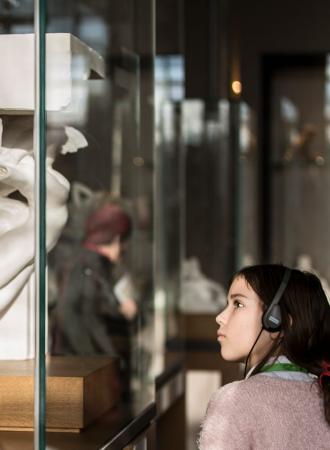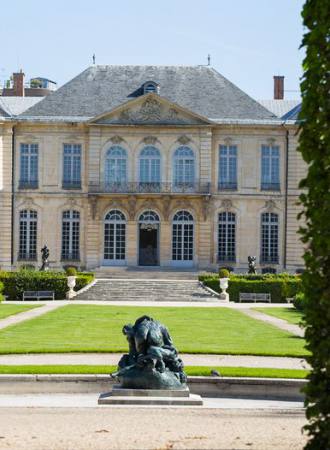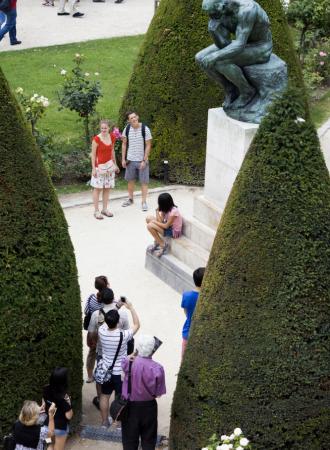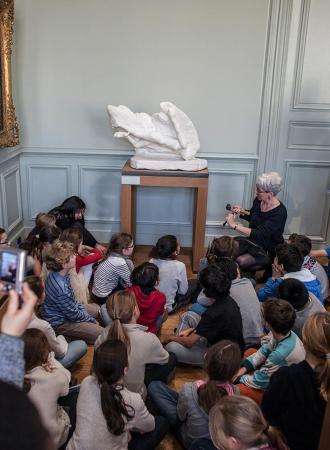Search the site
Rodin and Munch
There is no evidence of Rodin and Edvard Munch (1863-1944), the most important Norwegian artist and etcher of his generation, ever having met. Yet the sculptor’s work greatly influenced the painter’s production, and today the Musée Rodin is still the only French museum to own a canvas by Munch. In addition to this work, entitled Rodin’s “Thinker” in Dr Linde’s garden in Lübeck, painted in spring 1907 and acquired by the museum in 1981 (link to explanatory text, inv. P. 7612), is an etching printed in Berlin in 1902, acquired by the museum in 1985. The background history of this painting, which Rodin never had in his possession, and probably never saw, nonetheless reflects the extent to which the sculptor’s influence was felt in northern European countries, particularly in Munch’s work.
INTRODUCTION TO RODIN’S WORKS
When the young Munch first came to Paris for three weeks in 1885, he consciensciously visited the Louvre and the Salon. He also saw the bronze casts of Saint John the Baptist and The Age of Bronze. Rodin, who was then working on the initial phase of The Burghers of Calais, was not yet the internationally acclaimed artist that he would become a few years afterwards. Rodin, qui en est alors à la première phase d'élaboration des Bourgeois de Calais, n'est pas encore l'artiste internationalement reconnu qu'il sera quelques années plus tard.
In 1888, Copenhagen hosted a major exhibition of French art, represented by painters such as Delacroix, Courbet, Millet, Manet, Bastien-Lepage, Puvis de Chavannes, Monet, Sisley, Pissarro and Raffaëlli. A plaster version of Rodin’s The Thinker appeared in the “Sculpture” section. Munch saw the exhibition and was no doubt fascinated by this work, applauded by a certain Pictor in the periodical Kunstbladet: this “unpretentious little plaster statue” was “one of the finest works in the French exhibition”. It was “inspired by Michelangelo’s terribilità without ever being a pale imitation of it: this powerfully built man, who is leaning forward, lost in thought, as if tormented, is a true son of the 19th century…” (Kunstbladet, Copenhagen, 1888, no. 20/22, p. 248. Cited in Munch et la France, p. 54).
In autumn 1889, Munch returned to Paris, where he attended classes in Léon Bonnat’s studio until January 1890. By this time, Rodin was beginning to make a name for himself. He had worked out the overall design of The Gates of Hell,although the sculpture remained unfinished (link to explanatory text). A lithograph of the upper section, showing The Thinker surrounded by damned souls, was printed in the magazine L’Art Français (4 February 1888). The unfinished plaster of The Gates, together with The Thinker, could furthermore be seen in the studio that the French state had allocated Rodin, on the Rue de l’Université. These two works made a tremendous impression on many young artists, notably those from Germanic or Scandinavian countries, such as Max Klinger, who began his Beethoven in 1886, and the Norwegian sculptor Gustav Vigeland, so decisively influenced by Rodin, whom he praised no end, especially to his friend Edvard Munch.
The multiple trips to Paris made by Munch for various lengths of time in the 1890s, then between 1903 and 1906, all afforded him the opportunity to see Rodin’s works again – though he failed to actually meet the sculptor.
One particular episode in Munch’s career attests to how the painter missed his chance to meet Rodin. In 1899, the art historian Julius Meier-Graefe (co-founder of the Berlin periodical Pan in 1895), who wanted to promote Munch’s work in France, asked him to contribute to an album of original engravings to be published by his gallery, La Maison Moderne. However, the trial print submitted by the artist, a woodcut entitled The Island or Seascape, was judged unsuitable: it was so abstract that it was feared the public would not understand it. Despite the publisher’s pressing requests, Munch, whose health problems were beginning to emerge, did not send in another etching. By a strange irony of fate, he was therefore absent from the book that was supposed to promote his works alongside those of Behrens, Bonnard, Brangwyn, Carrière, Degas, Denis, Gauguin, Liebermann, Minne, Müller, Renoir, Stremel, Toorop, Toulouse-Lautrec, Vallotton, Van Gogh, Van Rysselberghe, Vuillard, Zuloaga – and Rodin.
DR LINDE’S COLLECTION
Dr Max Linde, a German ophthalmologist, collected paintings by Monet, Degas, Manet and Whistler. He first met and befriended Munch c.1902 and played a central role in fostering the painter’s knowledge of Rodin’s works.
Having purchased a “Young Girl with Child”, which was actually a cast of Brother and Sister (c. 1890, S.975) in Berlin, in 1898, Linde began corresponding with Rodin after the Pavillon de l’Alma exhibition of 1900 (his letters are now in the Musée Rodin archives). Often negotiating directly with the artist, he bought several of Rodin’s works (The Age of Bronze, Eve, The Crest and the Wave, Danaïd, Fugit Amor, The Nereids, Eternal Springtime, Sin, Mask of the Man with the Broken Nose, Fauness), some of which were placed outside in the formal French garden at his home in Lübeck.
In 1902, delighted with his purchases, Linde made Rodin a gift of two Japanese prints by Kitawaga Utamaro. The following year, Linde, who wanted to erect one of Rodin’s key works in his garden, learnt that the sculptor was in the process of enlarging The Thinker. He came to a decision: “This ‘Thinker’,” he wrote to Rodin, “placed alone, sheltered by hundred-year-old trees, will make a magnificent impact. You designed it for your ‘Gates of Hell’ as the principle which rises about human passions. It could thus be interpreted as what the artist sets against the universe: Homo sapiens contrasting with nature and vegetative life.”
Cast in 1903 specially for Linde, the bronze version of The Thinker was exhibited first in Leipzig in 1904, then in Berlin in early 1905, before finally being erected in Linde’s garden in Lübeck.
Irrespective of the fact that Munch had almost certainly seen reproductions of The Thinker, or bronze casts shown in Paris, he was able to view this work repeatedly thanks to Dr Linde, with whom he had become friends c.1902 (the Linde collection was dispersed after he went bankrupt in 1923. His Thinker is now in the United States, in Detroit).
In 1902, Munch drew his inspiration for the engaving that is now in the museum collections from Rodin’s Fauness. In 1906, his first painting of Dr Linde’s garden showed very free handling and a vivid palette (Park i Kösen, Kunsthistorisches Museum, Vienna). The silhouette of The Thinker appears in the background, behind the circular clearing. In spring the following year, Munch reworked the theme in the painting which is now in the museum collections. In this version, which is very different from the first, The Thinker occupies the foreground of the composition, while only a glimpse of the Linde family gathered in the garden can be seen in the background. The painting is filled with light and bright colour. The emphatic, sinuous outline of The Thinker forms a contrast with both the treatment of the vegetation in the middle ground, characterized by long, cross-hatched strokes, and the figures in the background, hastily sketched in with dabs of vivid colour.
A male nude in the midst of nature, The Thinker is entirely in keeping with the basic principles of vitalist philosophy, which, through Nietzsche’s writings, circulated in northern Europe circa 1900 and fuelled Munch’s artistic production.
The Norwegian painter cited Nietzsche amongst the artists and intellectuals of his personal pantheon (alongside Arnold Böcklin, Max Klinger, Hans Thoma and Richard Wagner), and painted an Allegorical Portrait of Friedrich Nietzsche (Thielska Galleriet, Stockholm) in 1906.
A SOURCE OF INSPIRATION
In 1903, Linde sent Rodin a booklet that he had written on Munch (Edvard Munch und die Kunst der Zukunft, 1902): its main topic was a comparison between Munch and Rodin. The sculptor never really voiced his opinion of Munch. His collection of paintings indicates that he preferred the works of other Scandinavian artists, stylistically more Impressionist than Expressionist, since it includes two paintings by Fritz Thaulow, as well as an oil by Karl-Edvard Diriks, Munch’s cousin, and one of his “promoters” amongst French artists and critics.
Linde was well aware of the role Rodin’s influence played in Munch’s works, as is evidenced by numerous borrowings of figures and subjects: The Kiss thus appeared in a painting dating from 1892 (Nasjonalgalleriet, Oslo), another canvas painted in 1897 (The Kiss, 1897, Munch Museet, Oslo) and a coloured woodcut, entitled Meeting in Outer Space (1898-99; Munch Museet, Oslo, cat. no. 136). This theme is also featured in Munch’s illustrations for an edition of Baudelaire’s Flowers of Evil (Rodin also illustrated an anthology of Baudelaire’s poems in 1887-88; inv. D. 7174). The figure of the man with raised right arm, inspired by The Age of Bronze, can be observed in a painting entitled Metabolism, 1899-1903 (Munch Museet, Oslo).
The motif of the seated man with head resting on his hand appears in numerous works on theme of meditation: Night (1890, Nasjonalgalleriet, Oslo), Melancholy–Evening (1891, private coll.), Melancholy, also known as The Yellow Boat (1892, Nasjonalgalleriet, Oslo), as well as in an engraving of the same name (1896, Munch Museet, Oslo). In these works, The Thinker is combined with recollections of other figures lost in contemplation: Dürer’s Melancholia, Fuseli’s Polyphemus, or the grief-stricken father in Géricault’s Raft of the Medusa.
Apart from a woodcut and a wash drawing after the Fauness belonging to Linde (which, together with photographs of Rodin’s works, was used to illustrate an article by Emil Heilbuts on Linde’s collection, published in 1904 in the Berlin periodical Kunst und Künstler), Rodin’s “Thinker” in Dr Linde’s Garden in Lübeck is the only example of a Munch painting with a sculpture as its central theme. This painting alone bears witness to how deeply Munch was influenced by The Gates of Hell, with which striking parallels are found in the ambitious (unfinished) cycle entitled Alpha and Omega (1908-09) and particularly in (Towards the Light) The Human Mountain (1909, Munch Museet, Oslo). Furthermore, Munch placed his paintings on symbolic themes around the entrance to his studio in Ekely, and he called this arrangement “my gates of hell”.
Rodin’s “Thinker” in Dr Linde’s Garden in Lübeck attests to the constant parallels between Munch and Rodin’s works. The painting in fact long remained in Munch’s studio without ever being shown. Linde himself was apparently unaware of its existence, despite the fact that it depicted one of the sculptures in his collection. Munch seems to have originally painted it for himself, as part of his own personal pantheon, condensing in a single figure some of the major themes that he borrowed from Rodin: the power of symbolism , existential vitalism and fear of death.
